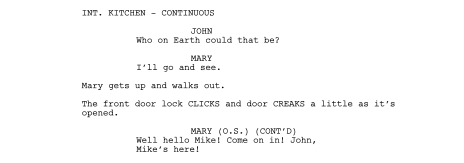- 5-minute read
- 22nd October 2020
5 Tips on How to Adapt a Novel into a Screenplay
At some point, most people have probably read a book and thought, ‘This would make a great film!’ But not everyone does anything about it. So, how do you adapt a novel into a screenplay? We have five top tips:
- Make sure you have permission to adapt the original work.
- Learn the basic format and style of a screenplay.
- Refine the story for the screen, focusing on the core themes.
- Think about how to adapt the novel for a visual medium.
- Proofread your screenplay to make sure it is error free.
For more detail on all the above, read our tips in full below.
1. Make Sure You Have the Rights to Adapt the Novel
The first step in adapting a novel into a screenplay is making sure you’re allowed to do it! If you wrote the novel you’re adapting yourself and still own the rights, then you’re good to go. But if another author wrote it, you’ll have to seek permission to adapt it first. This is because a screenplay based on an existing intellectual property is a derivative work, so the original author has control over who (if anyone) adapts it for the screen.
Unfortunately, if the author does not want to give you the rights, or if they’ve already licensed the rights, you might have to move on to another project. But there are always public domain works to adapt!
2. Learn How a Screenplay Works
Typically, screenplays and teleplays follow a specific format, with scene headings, action text, and dialogue all distinguished (unlike in a prose novel).

The next step in adapting a book into a screenplay, then, is to learn the screenplay format. Luckily, you can pick up the basics online for free, saving you from having to go to film school! And there are plenty of books on screenwriting that cover formatting a screenplay as well.
Read scripts from films and TV shows, too. As well as familiarising yourself with the format, this will give you a sense of how a good script flows.
And if you want to ensure things look professional, you can also get screenwriting software, which makes formatting a script much simpler.
3. Refine the Story for the Screen
One key difference between a novel and a screenplay is length. A novel may be hundreds, or even thousands, of pages. But if you tried to pack all this into a screenplay, the result would go on for hours! As such, you’ll want to find the core of what makes the novel compelling and focus on that.
Find this useful?
Subscribe to our newsletter and get writing tips from our editors straight to your inbox.
Each page of a screenplay equals roughly one minute of screen time. This means a screenplay for a film will usually be around 90 to 120 pages. And to adapt a full-length novel for a screenplay of this length, you’ll need to:
- Outline the story and pick out the key points of the narrative.
- Identify the themes of the novel and the motivations of the main character, then focus on aspects of the story that support these things.
- Cut subplots that aren’t essential to the main themes or plot.
- Think about combining scenes to keep the story moving.
- Cut minor characters or combine them into composite characters.
Remember, every scene should serve a purpose (e.g. telling us something important about a character, or moving the plot along). If a scene doesn’t affect anything else in the story, you will usually do well to cut it.
4. Adapt the Novel for a Visual Medium
When adapting a novel into a screenplay, you’re switching to a different medium. A novel is, typically, all words. But film and television are forms of visual storytelling, so you need to bring this out in the adaptation.
One example of this is minimising narration. A book needs a narrator to tell the reader what is happening: e.g. who is speaking, where scenes take place, what everything looks like. But a film will do most of this with visuals, so using a narrator can feel like lazy storytelling.
Thus, it’s better to use narration sparingly in screenplays.
If you’re relying on a narrator to explain things to the audience, think about how you could do this visually instead (e.g. instead of having a narrator outright tell us that a character is kind, add a short scene early on where the character in question does something caring and show us instead).
5. Proofread Your Adapted Screenplay
When you’ve finished drafting your screenplay, don’t forget to have it proofread! This will ensure it is error free, well formatted, and easy to follow.
It is easy to miss mistakes when proofreading your own writing, though. As such, you may want to try our expert proofreading services. Upload a 500-word trial document for free today to find out how we can help.